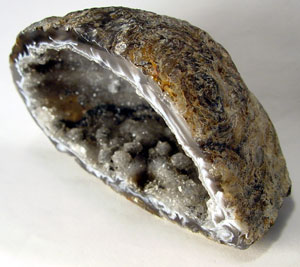
Age related macular degeneration (AMD) is the leading cause of central vision loss for Americans age 50 or greater. Risk factors include smoking, intense exposure to sunlight and most importantly, age. Aging of the photoreceptor cells and RPE is thought to be the primary pathophysiologic process contributing to macular degeneration. The two primary types of AMD are "dry" or nonexudative and "wet" or exudative macular degeneration. This post will focus on the previously posted images, highlighting dry AMD.
The primary findings in the above images, characteristic of dry AMD, are the cream colored nodules concentrated mostly around the central macular region. These are known as "drusen" which comes from the german word for geode.

These drusen are actually hyaline deposits within Bruch's membrane, which separates the RPE from the choriocapillaris. Drusen may distort the overlying retina enough to cause very subtle visual changes (metamorphopsia), but usually, they remain asymptomatic unless affecting the fovea itself. Drusen may be divided into several categories which represent the pathophysiological progression. Hard drusen are more refractile and have distinct borders. Soft drusen are the cream colored (often larger) bodies with blurred borders. Soft drusen may further coalesce into what are called confluent drusen. While drusen are mostly harmless in and of themselves, they are associated with the visually threatening outcome of dry AMD, Geographic Atrophy (GA). So-called geographic atrophy, when large areas of RPE becomes depigmented (seen as a window defect where the details of the choroid can clearly be seen), is most closely associated with soft and confluent drusen.
Drusen can often be most clearly demonstrated on fluorescein, later posts will highlight these as well as OCT imaging (very important in this day in age).
The BSCS series volume on Vitreoretinal disease devotes a relatively large portion of the text to AMD and is a good source.
No comments:
Post a Comment